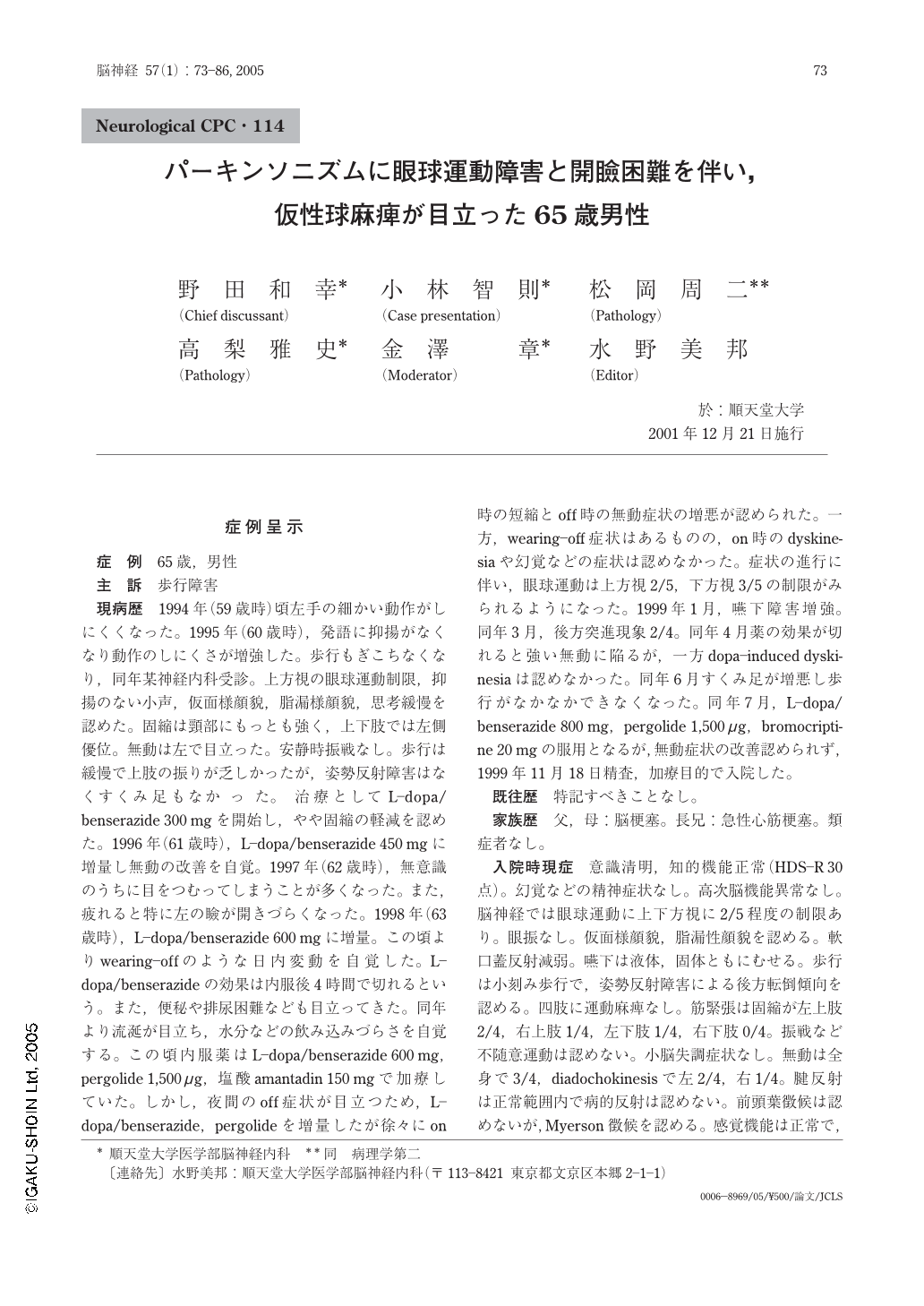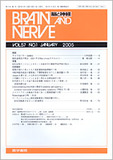Japanese
English
- 有料閲覧
- Abstract 文献概要
- 1ページ目 Look Inside
症例呈示
症 例 65歳,男性
主 訴 歩行障害
現病歴 1994年(59歳時)頃左手の細かい動作がしにくくなった。1995年(60歳時),発語に抑揚がなくなり動作のしにくさが増強した。歩行もぎこちなくなり,同年某神経内科受診。上方視の眼球運動制限,抑揚のない小声,仮面様顔貌,脂漏様顔貌,思考緩慢を認めた。固縮は頸部にもっとも強く,上下肢では左側優位。無動は左で目立った。安静時振戦なし。歩行は緩慢で上肢の振りが乏しかったが,姿勢反射障害はなくすくみ足もなかった。治療としてL-dopa/benserazide 300mgを開始し,やや固縮の軽減を認めた。1996年(61歳時),L-dopa/benserazide 450mgに増量し無動の改善を自覚。1997年(62歳時),無意識のうちに目をつむってしまうことが多くなった。また,疲れると特に左の瞼が開きづらくなった。1998年(63歳時),L-dopa/benserazide 600mgに増量。この頃よりwearing-offのような日内変動を自覚した。L-dopa/benserazideの効果は内服後4時間で切れるという。また,便秘や排尿困難なども目立ってきた。同年より流涎が目立ち,水分などの飲み込みづらさを自覚する。この頃内服薬はL-dopa/benserazide 600mg,pergolide 1,500μg,塩酸amantadin 150mgで加療していた。しかし,夜間のoff症状が目立つため,L-dopa/benserazide,pergolideを増量したが徐々にon時の短縮とoff時の無動症状の増悪が認められた。一方,wearing-off症状はあるものの,on時のdyskinesiaや幻覚などの症状は認めなかった。症状の進行に伴い,眼球運動は上方視2/5,下方視3/5の制限がみられるようになった。1999年1月,嚥下障害増強。同年3月,後方突進現象2/4。同年4月薬の効果が切れると強い無動に陥るが,一方dopa-induced dyskinesiaは認めなかった。同年6月すくみ足が増悪し歩行がなかなかできなくなった。同年7月,L-dopa/benserazide 800mg,pergolide 1,500μg,bromocriptine 20mgの服用となるが,無動症状の改善認められず,1999年11月18日精査,加療目的で入院した。
既往歴 特記すべきことなし。
家族歴 父,母:脳梗塞。長兄:急性心筋梗塞。類症者なし。
入院時現症 意識清明,知的機能正常(HDS-R 30点)。幻覚などの精神症状なし。高次脳機能異常なし。脳神経では眼球運動に上下方視に2/5程度の制限あり。眼振なし。仮面様顔貌,脂漏性顔貌を認める。軟口蓋反射減弱。嚥下は液体,固体ともにむせる。歩行は小刻み歩行で,姿勢反射障害による後方転倒傾向を認める。四肢に運動麻痺なし。筋緊張は固縮が左上肢2/4,右上肢1/4,左下肢1/4,右下肢0/4。振戦など不随意運動は認めない。小脳失調症状なし。無動は全身で3/4,diadochokinesisで左2/4,右1/4。腱反射は正常範囲内で病的反射は認めない。前頭葉徴候は認めないが,Myerson徴候を認める。感覚機能は正常で,自律神経機能異常なし(○/4はUPDRSのscore)。
入院後経過 L-dopa/benserazideを1,300mgまで増量し,歩行障害,無動はやや軽快したが,嚥下障害の改善は認めなかった。臨床的には垂直眼球運動障害を認め,転倒傾向が強いこと,抗パーキンソン病薬の効果が悪いことから進行性核上性麻痺(PSP)と診断した。
2000年8月(65歳時)嚥下困難が増悪し,薬はゼリーなどに混ぜて内服した。同年10月前屈姿勢が強くなり歩行障害も悪化した。同年11月9日,誤嚥によると思われる肺炎のため,近医に入院。抗生物質の投与で肺炎は軽快し退院したが,経口で摂取する量が減少し体重減少を認めた。このため再び2001年2月9日当科に入院した。入院時の胸部X-Pにて左下肺野に肺炎像を認め,喀痰を多量に認めた。経口摂取を中止し抗生剤を投与。炎症が落ち着いたところで経鼻胃管挿入し経管栄養を開始した。2001年2月11日,午前中車椅子でナースステーションに来るなど状態も落ち着いていたが,同日午後心肺停止状態のところを発見された。蘇生術は成功せず死亡を確認した。
We report a 65-year-old man with rigid-bradykinetic parkinsonism, vertical gaze palsy, difficulty in eye-lid opening, and marked pseudo-bulbar palsy. He felt difficulty of lt. hand movement at 59 years old. When he was 60 years old, monotonous speech and slowness of movement appeared. He visited a neurologist who noted vertical gaze palsy, neck rigidity, and bradykinesia. He was diagnosed as progressive supranuclear palsy(PSP) and given 300mg L-Dopa/Benserazide by the neurologist. This medication improved his rigidity and bradykinesia. At 62 years of the age, his eye-lids closed involuntary and it was difficult to open. In addition, he began to complain of wearing-off, autonomic symptoms, and dysphagia. Anti-parkinsonian drugs were increased, but his bradykinesia progressed. At 64 years of the age, he was admitted to the neurology service of Juntendo Hospital.
On admission, he was alert and not demented. No aphasia, apraxia, or agnosia was noted. In the cranial nerves, upward and downward gaze were markedly restricted. His face was hypomimic and seborrhoic. It was difficult to swallow liquid or solid for him. No weakness was noted, but he walked in small steps with freezing and falling tendency to backward. Rigidity was noted on his extremities and stronger on his left side than right. Tremor was absent. Bradykinesia of his body and extremities was marked. No cerebellar ataxia was noted. Deep tendon reflexes were within normal range. Planter response was flexor bilaterally. Myerson's sign was noted. Sensory and autonomic function were normal.
He was treated with L-Dopa, Pergolide, and Bromocriptine. However, these medications improved his bradykinesia and gait disturbance only slightly, dysphagia became progressively worse. He developed aspiration pneumonia when he was 65 years old and admitted to Juntendo Hospital. A large amount of sputum was aspirated from his trachea. Two days after from admission, he was found dead on his bed.
He was discussed in a neurological CPC and the chief discussant arrived at a conclusion that the patient had progressive supranuclear palsy(PSP). Other differential diagnoses included Parkinson's disease, pallidonigroluysian atrophy(PNLA), multiple system atrophy(MSA), and corticobasal degeneration(CBD). Many participants considered that PSP or PNLA was most likely.
Post-mortem exmination revealed marked nigral neuronal loss and gliosis. The globus pallidus and the luysian body changed mildly. However, the frontal cortex was relatively spared, there were many ballooned neurons in the cortical layer. Other parts were spared. With sliver(Bodian and Gallyas-Braak) and anti-phsphorylated tau stain, abundant astrocytic plaques, neurofibrillary tangles, and argyrophilic threads on the frontal cortex, striatum, and substantia nigra were seen. There was no tufted astrocyte which was hallmark of diagnosis of PSP. In addition, several Lewy bodies were seen in the brainstem. Because astrocyte plaque was considered specific for pathology of CBD, the pathologist revealed that the pathological diagnosis of this patient was CBD. Nevertheless, discussion was focused on the relatively mild degeneration of the frontal cortex for CBD.

Copyright © 2005, Igaku-Shoin Ltd. All rights reserved.


